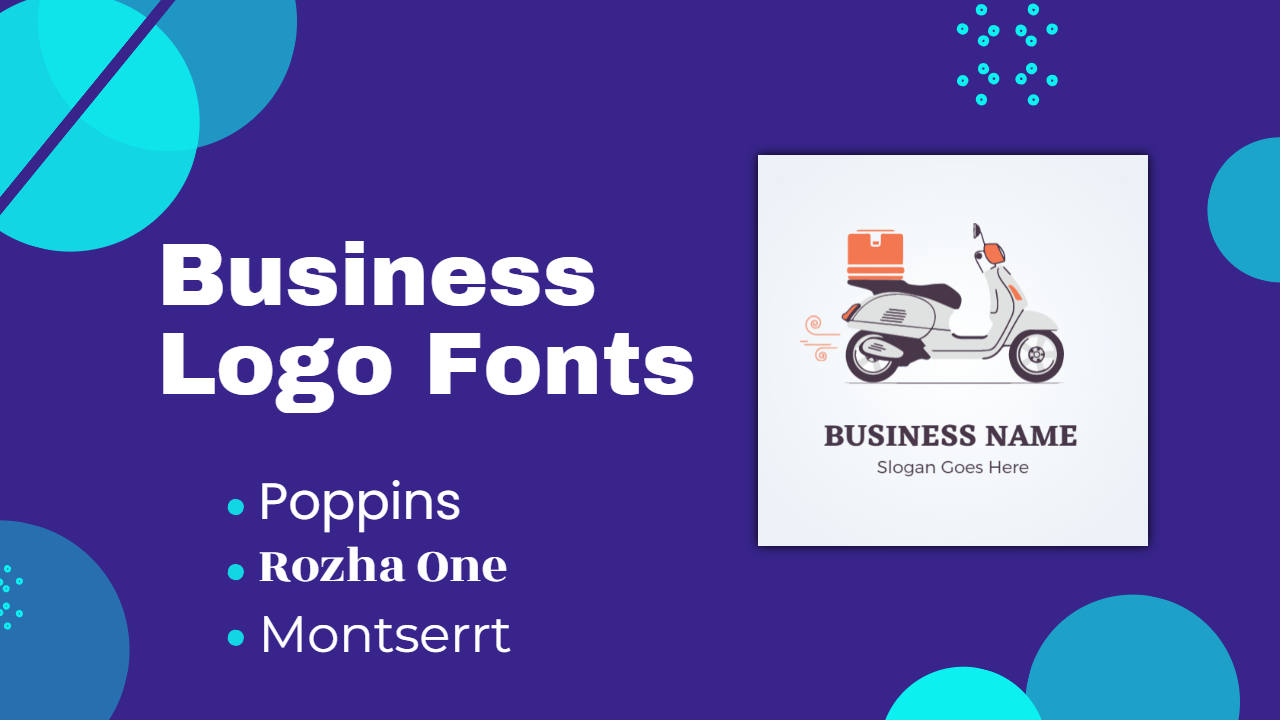In the realm of business, where visual communication is paramount, the choice of font for your logo is a decision not to be taken lightly. Your logo is the face of your brand, and the font you select plays a crucial role in shaping the perception of your business. Let’s embark on a comprehensive exploration of the intricacies involved in choosing the right typeface for your brand which is business logo fonts.
Importance of Business Logo Fonts
The significance of a well-chosen logo font cannot be overstated. Your logo serves as a visual representation of your brand’s identity, values, and personality. The font you choose when you create a business logo communicates a silent yet powerful message to your audience, impacting their perception of your brand from the first glance.
Understanding Typeface Basics
Serif vs. Sans-serif
Serif fonts, with their decorative strokes, often convey a sense of tradition and reliability. Sans-serif fonts, on the other hand, project a modern and clean aesthetic. Understanding the characteristics of each aids in aligning your font choice with your brand’s personality and message.
Script Fonts
Script fonts bring a touch of personality and style to your logo. They can convey a sense of elegance, friendliness, or creativity, depending on the script’s design. Consideration of your brand’s personality is crucial in selecting the appropriate script font.
Modern and Display Fonts
Modern and display fonts break away from traditional styles, offering a contemporary feel. These fonts are often used to make a bold statement and can be particularly effective for brands aiming for a cutting-edge image.
Psychology of Fonts in Branding
The psychology behind fonts is a fascinating aspect of logo design. Different fonts evoke varied emotions and perceptions. Serif fonts may instill a sense of reliability, while sans-serif fonts can create a feeling of modernity. Understanding the psychological impact of fonts enables you to craft a logo that resonates with your target audience on an emotional level.
Consider the success stories of brands like Coca-Cola and IBM. The distinct font choices for their logos have contributed significantly to their global recognition and positive consumer associations.
Legibility and Readability
No matter how visually appealing a font may be, its effectiveness diminishes if it compromises legibility and readability. In logo design, where often the space is limited, ensuring that your font maintains clarity across different platforms is paramount. Consider the variations in desktop, mobile, and print contexts to guarantee optimal visibility.
Accessibility considerations are also crucial. A font that looks great but is challenging to read may exclude portions of your audience. Striking a balance between aesthetics and functionality is key.
Brand Consistency
Consistency is the bedrock of successful branding. Your logo font should seamlessly align with your brand’s personality and remain consistent across all marketing materials. Whether it’s your website, social media profiles, or print collateral, maintaining a cohesive brand image reinforces recognition and trust among your audience.
Consider creating a brand guide that outlines the specific use of your chosen font, ensuring consistency in size, spacing, and color across diverse platforms.
Trends in Logo Fonts
In the ever-evolving landscape of design, staying abreast of current font trends is essential. Platforms like Google Fonts and Adobe Typekit offer a plethora of options. However, it’s crucial to balance trendy choices with timeless options. While contemporary fonts may be appealing, they run the risk of becoming outdated quickly. Strive for a harmonious blend of the current and the enduring.
Analyzing the font choices of successful brands like Nike reveals a balance between modernity and timelessness. The iconic swoosh symbol coupled with a clean, sans-serif font has stood the test of time.
Custom vs. Pre-designed Fonts
The decision between custom and pre-designed fonts hinges on various factors. Custom fonts offer a unique branding opportunity, ensuring that your logo stands out from the crowd. However, they come with a higher cost and longer development time. Pre-designed fonts, while more accessible, may lack the exclusivity that custom fonts provide.
Exploring examples like the distinctive Coca-Cola font highlights how a custom font can become synonymous with a brand, contributing to its identity and recognition.
Mobile Responsiveness
In an era dominated by mobile devices, ensuring that your logo font translates seamlessly to smaller screens is imperative. Responsive design principles dictate optimal font sizes for various devices, preventing loss of visibility and legibility on smartphones and tablets.
Testing your logo on multiple devices and adjusting font sizes accordingly ensures a positive user experience across diverse platforms.
Testing and Feedback
Selecting the perfect logo font involves a process of testing and gathering feedback. A/B testing on your website can provide valuable insights into how different fonts resonate with your audience. Additionally, seeking feedback from your target demographic ensures that your font choice aligns with their preferences and expectations.
The iterative design process, based on continuous testing and feedback, allows for refinement and improvement, resulting in a logo font that effectively communicates your brand’s essence.
Legal Considerations
Amidst the creative process, it’s crucial not to overlook the legal aspects of font usage. Fonts are intellectual property, and understanding licensing and usage rights is paramount. Different fonts come with various licensing models, ranging from free for personal use to paid commercial licenses.
To avoid legal pitfalls, always adhere to the terms of use outlined by the font creator. Instances of copyright infringement in font usage underscore the importance of due diligence in legal considerations.
Case Studies
Examining real-world examples of successful logo fonts provides valuable insights for your own design journey. Brands like Apple and Starbucks showcase how font choices can contribute to the overall brand image and recognition.
Apple’s use of a sleek, modern font complements its innovative and cutting-edge brand image. Starbucks, on the other hand, opts for a more traditional and decorative font, aligning with its focus on craftsmanship and quality.
Collaboration Between Designers and Marketers
Effective collaboration between designers and marketers is pivotal in the font selection process. Clear communication of brand goals, values, and target audience considerations ensures that the chosen font aligns with broader marketing strategies.
Establishing regular updates and feedback loops fosters a collaborative environment, allowing for the creation of a logo that not only looks visually appealing but also aligns seamlessly with marketing goals.
Balancing aesthetics with marketing goals requires an understanding of the target audience and the message the brand seeks to convey. The synergy between design and marketing ensures that your logo font becomes a strategic asset in your overall brand strategy.
Optimizing for SEO
In the digital age, where online visibility is paramount, incorporating SEO considerations into logo design is a savvy move. Search engine crawlers recognize text-based content, making it essential to have text within your logo. This doesn’t mean compromising on design; rather, it involves thoughtful integration of text elements that enhance both aesthetics and search engine optimization.
Descriptive file names and alt text for logo images contribute to accessibility and SEO. Ensuring that your logo is search engine-friendly enhances its discoverability and visibility online.
Conclusion
Choosing the right business logo fonts is a nuanced and multifaceted process that involves understanding typeface basics, considering the psychology of fonts, ensuring legibility and readability, and maintaining brand consistency. By balancing design trends with timeless choices, considering mobile responsiveness, testing rigorously, and collaborating effectively between designers and marketers, you can create a logo that not only looks appealing but also effectively communicates your brand’s essence to your target audience.
FAQs about Business Logo Fonts
Can I use multiple fonts in my business logo?
While it’s possible, it’s generally advisable to stick to one or two fonts for clarity and consistency. Using too many fonts can create visual clutter.
How often should I update my logo font to stay current?
Avoid frequent updates. A well-chosen, timeless font can remain relevant for many years. Consider updating only if there’s a significant shift in brand identity or if the current font becomes outdated.
Are there specific fonts associated with certain industries?
While certain fonts may be more commonly used in specific industries (e.g., serif fonts in finance), the choice should ultimately reflect your brand’s personality and values.
What role does color play in logo font selection?
Color and font are interconnected. Consider how your chosen font complements your brand’s color scheme. Ensure there’s enough contrast for readability, especially in monochromatic or minimalist designs.
Is it necessary to hire a professional designer for logo font selection?
While it’s beneficial, especially for custom fonts, you can explore font options independently using online resources and tools. However, professional guidance ensures a polished and effective result.
Also, read:
Unlocking Success with a Content Creation Marketing Agency




